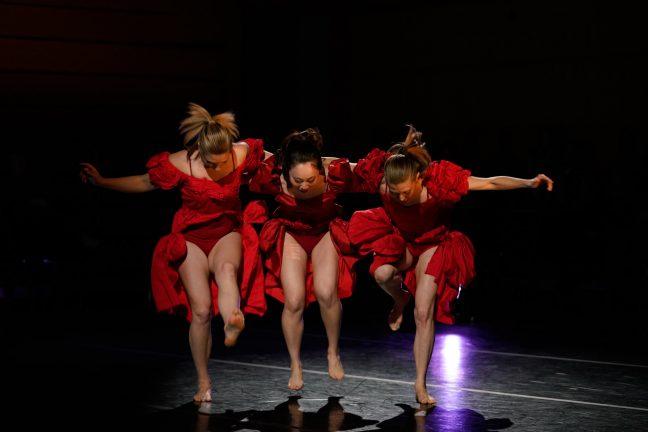As guests of Dolce Stil Novo entered the Masonic Center Auditorium Saturday afternoon, a barefooted woman greeted each individual warmly to the show as she shared instructions to sit anywhere they would like, provided they take caution when stepping near the dance floor. This friendly face was none other than Li Chiao-Ping, founder of Li Chiao-Ping Dance (LCPD).
For the first time, LCPD presented “Dolce Stil Novo” — “a feast for the senses” of dance and theater to Madison connoisseurs and newfound appreciators of the arts alike.
LCPD is a Madison based non-profit organization whose mission is “to support, produce and promote original inventive, and thought-provoking contemporary choreography.” Through their Dec. 1 performance, the company continued to fulfill this mission — allowing audience members to reflect on the intention behind each piece of the program.
Dolce Stil Novo which is Italian for “sweet new style” refers to a 13th-century Italian literature style of poetry where the main themes are love and introspection.
Parallel to the methods of Italian poets, this female-focused show derived its inspiration from contemplating the concept of women and celebrating them in return via a perplexing combination of various art forms.
The multidisciplinary performance featured five acclaimed artists — fashion designer Emily Popp, lighting designer John Frautschy, musician Julia McConahay, visual artist Chele Isaac, and artistic director and choreographer Li Chiao-Ping. In addition to these roles, Popp, McConahay and Chiao-Ping played physical parts in the performance accompanied by several company members, guest artists and student dancers from the University of Wisconsin.
Because of the knowledge brought from collaborating artist professor Patrick Rumble, the essence and significance of Italian culture were displayed subtly, yet significantly throughout “Dolce Stil Novo.” Rumble specializes in the history of numerous Italian disciplines, including Italian cinema, literature, culture and society at UW.
The first piece represented this Italian connection with musical accompaniment “Mercè, dilette amiche” from the opera “I vespri siciliani” by Italian composer Giuseppe Verdi.
But before this song began, complete silence filled the auditorium space as the women who took the dance floor displayed playful, yet powerfully partnered choreography intermixed with featured solos and non-synchronization — setting the tone for the near ninety minute performance.

John Maniaci/John Maniaci Photography
This first dance was followed by UW MFA candidate Emily Popp’s 100 Pound Dress, a garment weighing in at exactly 104.5 pounds which sat on the dance floor waiting to be worn by six people, including Popp. The individuals modeled the dress by walking carefully across the floor, stretching apart at times to show off its various segments to the audience as an audio recorded explanation behind the piece played along.
“The stories are there, but I don’t know what they are. So I can only try to feel them with my body and not necessarily understand with my mind,” Popp said.
The five other models removed themselves from the dress — wrapping Popp in the hefty material, sewn together earlier in 2018, she is still feeling to understand.

John Maniaci/John Maniaci Photography
Popp’s fashion exhibit was followed by the premiere of a number of distinctive pieces, including “reDress/age” performed by five UW student dancers, “Enchanting Girl,” and “Woman of the Year” featuring audio from “100 Women challenge: Breaking the glass ceiling” by BBC News.
“It sounds like, in many cases, women aren’t just hitting a glass ceiling, they might also be climbing a broken ladder,” the narrator posited. The theatrical aspect of this number was performed animatedly by Liz Sexe who managed to build the ladder back together, stripping away the traditional women’s business clothing and high heels she wore which allowed her to present a newfound sense of freedom.
A similar sense of freedom or liberation emulated from the dances to follow, accompanied by beautifully colored lights which lined the dance floor as well as the wings from above.
Madtown runway: UW’s growing fashion scene gives students opportunities to advance design skills
The visual art component of the show developed throughout in “Three considerations before choreographing the End” — a three part video that began to seem more connected as each figure was displayed, being further interpreted and understood by audience members as the final numbers neared.
In the last two premiered pieces, “Endgame” and “Fortuna”, McConahay rocked out on her fiddle as she played musical accompaniment to those dancing while she graced the dance floor — serving as another creative, interactive element to end the show on a high note (literally).
UW Dance Department: A firsthand look into five campus dance organizations
“At times, we focus on the negative, what is not working, or disappointing, or infuriating. But, let’s focus on the positive: your health, education, home, job, food, and clothing. What good fortune! Dear Fortuna!” Chiao-Ping wrote at the end of her message from the artistic director. This message was well-received from audience members whose approval through applause echoed across the room following each number.
Through the power of movement and dance, LCPD proved how so much can be said without actually saying anything. The earnest performance was joined by moments of comedy which led to such a highly intimate, enamor-filled ending.
For those who missed the real-time, thought-provoking experience of the program, “Dolce Stil Novo” is part of a larger work expected to premiere in the spring of 2020.


